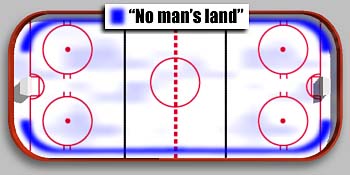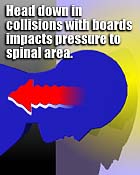

04/09/96 - 11:20 AM ET - Click reload often for latest version
Each week, USA TODAY will feature a leading college coach providing tips on improving hockey skills. This week's guest coach is Joe Mallen of the University of Massachusetts Amherst.
Featuring Coach Joe Mallen, University of Massachusetts Amherst


In light of the injuries sustained by Boston University freshman Travis Roy, hockey players, coaches, parents and fans are asking questions about how to avoid serious injury in collisions with the boards. Roy crushed the fourth cervical vertebra of his back as a result of his head-on crash into the boards in BU's game versus North Dakota on Oct. 20. Roy had surgery on Oct. 23. Due to spinal shock and pneumonia, the exact extent of the injury has yet to be determined, although quadriplegia (extensive paralysis) is considered the most likely outcome.
Joe Mallen, coach of HOCKEY EAST's University of Massachusetts Amherst program, felt it important to address falling into the boards with his players, several of whom had played with or against Roy during their youth hockey careers. Mallen and the team's head trainer, Bob Williams, stressed one important message: "Keep your head up when facing the boards."
"There's a lot more information available these days from studies that have been done, primarily for football but also relating to other contact sports, that shows that the most important thing to avoid in direct contact is to have your head down," said Mallen. "Whether your head is up or down determines whether the impact of the collision is absorbed by the spinal cord or other parts of the body. When your head is down, the spinal cord will bear the brunt of the contact. When your head is up, you'll probably receive injuries such as a concussion, a broken nose, a sprained neck, but you'll walk away. They probably won't be injuries to your spinal cord."
According to Mallen, Roy's situation was "an accident, a tragic incident. Who knows why things like this happen?" He did not relate the injury to the style of check or whether or not Roy may have had minimal contact with the North Dakota player, who stepped away from the check, before losing his balance and crashing into the board.
"I watched the replays of the accident, and as far as I could tell Travis didn't have contact with the North Dakota player. But it did look like he may have dropped his head just before meeting the boards," said Mallen. "Hockey players have good reaction time. There's almost always a second or two before meeting the boards. How many times have you seen a guy go hard towards the board and get a skate up to dig into the ice and jump up before he actually hits the boards? It's during that time between recognition and the collision a player needs to call on his reaction skills and face the boards. Face the boards and put your head up. If the player does that, his injuries probably won't be tragic."
"I encourage all my players and all hockey players, coaches and parents to actively seek out video tapes, such as Mike Bossy's tape, and sport journal articles about making contact with the boards," said Mallen.
One subject such articles and video tapes focus on is "no man's land," the area of three to five feet from the boards. The danger of "no man's land" is in being too far from the boards. Most hockey educators advocate safe checking to be right along the boards or further than six feet away from the boards. While a player is less in control of getting hit in "no man's land," he is very much in control of checking other players in that area; it is a very dangerous place for a checker to position himself. A checker in "no man's land" runs the risk that if he misses the opposing player he aims to check or loses his balance, he is too far away from the boards to have the boards support the length of his body. In that situation then, the checker's momentum causes the most contact to be between the boards and the checker's head and neck area.
NCAA college hockey trainers and coaches also use as a reference the eighth edition (August 1995) of the NCAA Sports Medicine Handbook, which refers to a section, "Use of the Head as a Weapon in Football and Other Contact Sports." It says that "most of these catastrophic injuries result from initiating contact with the head." It also uses a reproduction of an National Football League poster to stress its point of heads up play, which states, "Play HEADS UP (Football, Hockey, Lacrosse, etc.). Remember . . . See What You Hit! Protect Your Spine and Neck."
Joe Mallen is in his third year as coach of the UMass-Amherst Minutemen hockey program and his eighth season as a collegiate head coach. In his first two years at UMass-Amherst, he had a 26-37-2 record (.415). Overall, he has a 106-83-4 mark (.560). Mallen began his head coaching career at UMass-Boston (1979-85), a Division II program where two of his squads (1981-82 and '82-83) advanced to the divisional championship playoffs. Following his five years at UMass-Boston, Mallen was an assistant coach at U.S. International University for one season, then was an assistant coach at Boston College for coach Len Ceglarski for seven years. While at BC, the Eagles won 164 games and advanced to five NCAA tournaments.